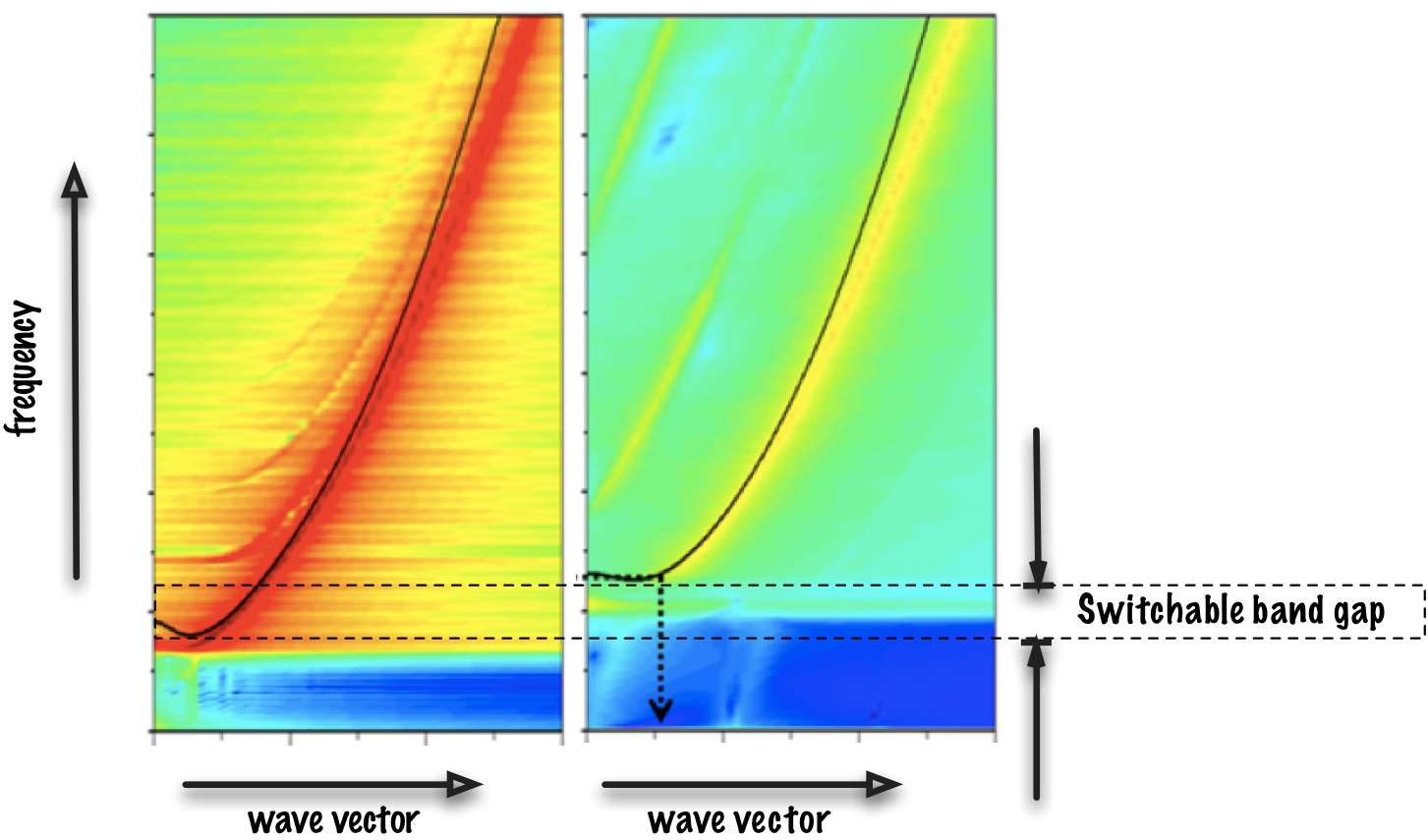Not quite so technical summary of our recent paper on switchable band gap for magnons:
Qi Wang, Huaiwu Zhang, Xiaoli Tang, Hans Fangohr, Feiming Bai, Zhiyong Zhong onDynamic control of spin wave spectra using spin-polarized currents in
Applied Physics Letters 105, 112405 (2014)
(Online: journal postprint pdf arXiv.org)
Context: Magnonics
Magnonics combines waves and magnetism, its main aim is to investigate the behaviour of spin waves propagating in ferromagnetic nano-structure elements.
Magnons are magnetic excitations, also known as spin-waves: if we disturb the magnetisation in a ferromagnet at some location, this excitation will travel like a wave through the device.
By chosing suitable materials, geometries and excitations of the system, the community is trying to develop suitable designs that can be extended and combined to develop magnonics-based communication, data storage and processing devices.
Bandgaps
Magnetic (spinwaves) have a precession frequency and a wave vector, and great attention is paid to the systematic study of how frequency and wave vector correlate: the plot of the frequency against the wave vector is called a dispersion relation. These dispersion relations can be obtained using computer simulations (see this example from the Nmag simulation package).
Amongst other things, the dispersion relation tells us for what frequency ranges waves can propagate through the system. Of particular interested are geometries and (meta-)materials that prevent wave propagation at particular frequencies: we say that they exhibit a 'band gap' in the dispersion relation.
This study
This study computes the dispersion relation (Figure A) for a rectangular sample and shows that a band gap can be activated and de-activated by running a (spin-polarised) electric current through a strip wire that goes across the sample. The overall geometry is shown in figure B below.

Figure A: (Left plot:) The dispersion relation for the system under study in the absence of any electric current. (Right plot:) The dispersion relation when the ground configuration of the magnetisation is disturbed through a (spin-polarised) electric current. The colours show the intensity of spinwaves for the given frequency and wave vector, where red is high and blue is low.
The box drawn with a dashed line indicates those frequencies in which a spin wave can travel through the system as shown on the left, but can not propagate for the system shown on the right. In other words: if the current is flowing, the magnon devices does not transmit, and if the current stops, the magnons can travel along the device.
We are looking at a magnon switch that can be operated with an applied voltage.
Why is this exciting?
The ability to switch the band gap on and off using an electric current paves the way to magnonic devices where propagation of magnons (in the right frequency range) can be allowed or suppressed, and where the switching between the two modes can be achieved by an electric current (thus connecting to established electronics, which is generally good).
How does it work?
The current that is injected from the strip going across the rectangle carries spin-polarised electrons which transfer their spin into the magnetisation and in the process excite the magnetisation. The spin waves travel in the non-excited areas of the system, and thus the effective width that the spin waves can see is reduced. Changing the width changes the dispersion relation.

Figure B: The geometry of the simulated device. The line injecting the current is mounted under the thin film, and the current is flowing in the direction of the red arrow, from bottom to top. The turquoise layer in the line is magnetically polarised and the electrons travelling through the line will also be polarised when they reach the spacer layer, and transfer their spin onto the magnetisation in the thin film when they reach it, thus exciting the magnetisation in the area above the strip, and modifying the effective dispersion relation for travelling spin waves.
Summary
- Study spin wave propagation in thin film using numerical simulation,
- using OOMMF simulation package,
- compute dispersion relation,
- apply current and spin-torque transfer term in parts of the sample, and compute dispersion relation in presence of this excitation
- have identified design where a bandgap emerges in the presence of the spin-torque term, i.e.
- found a magnon gate switchable by an electric current.
- Switching time is of the order of nanoseconds.
Future work
Magnonics is an active field of research - if you are interested to pursue a PhD in computational modelling of such systems, please get in touch.
Full text access and paper details
Qi Wang, Huaiwu Zhang, Xiaoli Tang, Hans Fangohr, Feiming Bai, Zhiyong Zhong: "Dynamic control of spin wave spectra using spin-polarized currents" in Applied Physics Letters 105, 112405 (2014)
PDFs are available from: